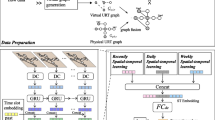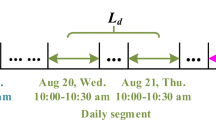Abstract
Metro system has been increasingly recognized as a backbone of urban transportation system in many cities around the world. To improve the demand management and operation efficiency, it is crucial to have accurate prediction of real-time metro passenger flow. However, the forecast performance is often subject to the complex spatial and temporal distributions of the metro passenger flow data. To this end, we developed a novel dual attentive graph neural network that can effectively predict the distribution of metro traffic flow considering the spatial and temporal influences. Specifically, two directed complete metro graphs (i.e., inbound and outbound graphs) and the weighted matrix of them are proposed to characterize the inbound (entering the system) and outbound (leaving the system) passenger flow, respectively. The weighted matrix of inbound graph is estimated based on the historical origin-destination demand and that of the outbound graph is estimated based on the similarity metrics between every two stations. Moreover, to capture the dependencies between inbound and outbound flows, multi-layer graph spatial attention networks that incorporate the spatial context are applied to exploit the dynamic inter-station correlations. Then, the acquired dependency features integrated with external factors, such as weather conditions, are filtered by temporal attention and fed into a sequence decoder to produce short-term and long-term passenger flow predictions. Finally, a series experiments are conducted based on a comprehensive empirical dataset. Findings indicated that the proposed model does not only well predict the metro passenger flow, but also effectively detect the emergencies and incidents of metro system.









Similar content being viewed by others
Explore related subjects
Discover the latest articles, news and stories from top researchers in related subjects.References
De Borger B, Kerstens K, Costa A (2002) Public transit performance: What does one learn from frontier studies? Transp Rev 22(1):1–38
Li H, Ding H, Ren G, Xu C (2018) Effects of the london cycle superhighways on the usage of the london cycle hire. Transp Res Pt A-Policy Pract 111:304–315
Ding H, Sze N, Li H, Guo Y (2020) Roles of infrastructure and land use in bicycle crash exposure and frequency: a case study using greater london bike sharing data. Accid Anal Prev 144:105652
Zhong C, Batty M, Manley E, Wang J, Wang Z, Chen F, Schmitt G (2016) Variability in regularity: Mining temporal mobility patterns in london, singapore and beijing using smart-card data. PLoS One 11(2):e0149222
Li Y, Wang X, Sun S, Ma X, Lu G (2017) Forecasting short-term subway passenger flow under special events scenarios using multiscale radial basis function networks. Transp Res Pt C-Emerg Technol 77:306–328
Tang L, Zhao Y, Cabrera J, Ma J, Tsui KL (2018) Forecasting short-term passenger flow: An empirical study on shenzhen metro. IEEE Trans Intell Transp Syst 20(10):3613–3622
Chen E, Ye Z, Wang C, Xu M (2019) Subway passenger flow prediction for special events using smart card data. IEEE Trans Intell Transp Syst 21:1109–1120
Gong Y, Li Z, Zhang J, Liu W, Zheng Y, Kirsch C (2018) Network-wide crowd flow prediction of sydney trains via customized online non-negative matrix factorization. In: CIKM, pp 1243–1252
Ahmed MS, Cook AR (1979) Analysis of freeway traffic time-series data by using box-jenkins techniques. Transp Res Record 722:1–9
Williams BM, Durvasula PK, Brown DE (1998) Urban freeway traffic flow prediction: application of seasonal autoregressive integrated moving average and exponential smoothing models. Transp Res Record 1644(1):132–141
Williams BM, Hoel LA (2003) Modeling and forecasting vehicular traffic flow as a seasonal arima process: theoretical basis and empirical results. J Transp Eng 129(6):664–672
Van Der Voort M, Dougherty M, Watson S (1996) Combining kohonen maps with arima time series models to forecast traffic flow. Transp Res Pt C-Emerg Technol 4(5):307–318
Smith BL, Demetsky MJ (1997) Traffic flow forecasting: comparison of modeling approaches. J Transp Eng 123(4):261–266
Leshem G, Ritov Y (2007) Traffic flow prediction using adaboost algorithm with random forests as a weak learner. WASET, Citeseer 19:193–198
Crosby H, Davis P, Jarvis SA (2016) Spatially-intensive decision tree prediction of traffic flow across the entire uk road network. In: DS-RT, IEEE, pp 116–119
Wu CH, Ho JM, Lee DT (2004) Travel-time prediction with support vector regression. IEEE Trans Intell Transp Syst 5(4):276–281
Xu H, Jiang C (2019) Deep belief network-based support vector regression method for traffic flow forecasting. Neural Comput Appl pp 1–10
Sun S, Zhang C, Yu G (2006) A bayesian network approach to traffic flow forecasting. IEEE Trans Intell Transp Syst 7(1):124–132
Pascale A, Nicoli M (2011) Adaptive bayesian network for traffic flow prediction. In: SSP, IEEE, pp 177–180
Lu Y, He Z, Luo L (2019) Learning trajectories as words: a probabilistic generative model for destination prediction. In: MobiQuitous, pp 464–472
Zhao SZ, Ni TH, Wang Y, Gao XT (2011) A new approach to the prediction of passenger flow in a transit system. Comput Math Appl 61(8):1968–1974
Hodge VJ, Krishnan R, Austin J, Polak J, Jackson T (2014) Short-term prediction of traffic flow using a binary neural network. Neural Comput Appl 25(7–8):1639–1655
Chen Q, Song Y, Zhao J (2020) Short-term traffic flow prediction based on improved wavelet neural network. Neural Comput Appl
Wu Y, Tan H, Qin L, Ran B, Jiang Z (2018) A hybrid deep learning based traffic flow prediction method and its understanding. Transp Res Pt C-Emerg Technol 90:166–180
Zhang J, Zheng Y, Qi D, Li R, Yi X, Li T (2018) Predicting citywide crowd flows using deep spatio-temporal residual networks. Artif Intell 259:147–166
Zhang J, Zheng Y, Sun J, Qi D (2019) Flow prediction in spatio-temporal networks based on multitask deep learning. IEEE Trans Knowl Data Eng 32(3):468–478
Zhang Y, Zhou Y, Lu H, Fujita H (2020) Traffic network flow prediction using parallel training for deep convolutional neural networks on spark cloud. IEEE Trans Ind Inform 16:7369–7380
Li Y, Yu R, Shahabi C, Liu Y (2018) Diffusion convolutional recurrent neural network: Data-driven traffic forecasting. In: ICLR
Yu B, Yin H, Zhu Z (2018) Spatio-temporal graph convolutional networks: a deep learning framework for traffic forecasting. In: IJCAI, pp 3634–3640
Chen C, Li K, Teo SG, Zou X, Wang K, Wang J, Zeng Z (2019) Gated residual recurrent graph neural networks for traffic prediction. AAAI 33:485–492
Wang X, Ma Y, Wang Y, Jin W, Wang X, Tang J, Jia C, Yu J (2020) Traffic flow prediction via spatial temporal graph neural network. In: WWW, pp 1082–1092
Zheng C, Fan X, Wang C, Qi J (2020) Gman: A graph multi-attention network for traffic prediction. AAAI 34:1234–1241
Hochreiter S, Schmidhuber J (1997) Long short-term memory. Neural Comput 9(8):1735–1780
Rumelhart DE, Hinton GE, Williams RJ (1986) Learning representations by back-propagating errors. Nature 323(6088):533–536
Hochreiter S (1998) The vanishing gradient problem during learning recurrent neural nets and problem solutions. Int J Uncertainty Fuzziness Knowl-Based Syst 6(02):107–116
Beck D, Haffari G, Cohn T (2018) Graph-to-sequence learning using gated graph neural networks. In: ACL, pp 273–283
Keogh EJ, Pazzani MJ (2001) Derivative dynamic time warping. In: SDM, SIAM, pp 1–11
Berndt DJ, Clifford J (1994) Using dynamic time warping to find patterns in time series. KDD workshop, Seattle, WA 10:359–370
Veličković P, Cucurull G, Casanova A, Romero A, Lio P, Bengio Y (2017) Graph attention networks. arXiv preprint arXiv:171010903
Vaswani A, Shazeer N, Parmar N, Uszkoreit J, Jones L, Gomez AN, Kaiser L, Polosukhin I (2017) Attention is all you need. In: NIPS, vol 31
Devlin J, Chang MW, Lee K, Toutanova K (2018) Bert: Pre-training of deep bidirectional transformers for language understanding. arXiv preprint arXiv:181004805
Fu J, Liu J, Tian H, Li Y, Bao Y, Fang Z, Lu H (2019) Dual attention network for scene segmentation. In: CVPR, pp 3146–3154
Ji Y, Zhang H, Wu QJ (2018) Salient object detection via multi-scale attention cnn. Neurocomputing 322:130–140
Ji Y, Zhang H, Jie Z, Ma L, Wu QJ (2020) Casnet: a cross-attention siamese network for video salient object detection. IEEE Trans Neural Netw Learn Syst
Maas AL, Hannun AY, Ng AY (2013) Rectifier nonlinearities improve neural network acoustic models. In: ICML, vol 30, p 3
He K, Zhang X, Ren S, Sun J (2016) Deep residual learning for image recognition. In: CVPR, pp 770–778
Liu Y, Liu Z, Jia R (2019) Deeppf: A deep learning based architecture for metro passenger flow prediction. Transp Res Pt C-Emerg Technol 101:18–34
Liang Y, Ke S, Zhang J, Yi X, Zheng Y (2018) Geoman: Multi-level attention networks for geo-sensory time series prediction. In: IJCAI, pp 3428–3434
Nair V, Hinton GE (2010) Rectified linear units improve restricted boltzmann machines. In: ICML, pp 807–814
Kingma DP, Ba J (2014) Adam: A method for stochastic optimization. arXiv preprint arXiv:14126980
Ma X, Zhang J, Du B, Ding C, Sun L (2018) Parallel architecture of convolutional bi-directional lstm neural networks for network-wide metro ridership prediction. IEEE Trans Intell Transp Syst 20(6):2278–2288
Hao S, Lee DH, Zhao D (2019) Sequence to sequence learning with attention mechanism for short-term passenger flow prediction in large-scale metro system. Transp Res Pt C-Emerg Technol 107:287–300
Author information
Authors and Affiliations
Corresponding author
Ethics declarations
Conflict of interest
The authors declare that they have no conflict of interest.
Additional information
Publisher's Note
Springer Nature remains neutral with regard to jurisdictional claims in published maps and institutional affiliations.
Rights and permissions
About this article
Cite this article
Lu, Y., Ding, H., Ji, S. et al. Dual attentive graph neural network for metro passenger flow prediction. Neural Comput & Applic 33, 13417–13431 (2021). https://doi.org/10.1007/s00521-021-05966-z
Received:
Accepted:
Published:
Issue Date:
DOI: https://doi.org/10.1007/s00521-021-05966-z





